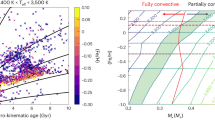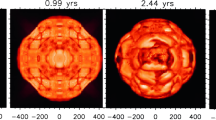Abstract
The evolution of a solar-mass star before and on the main sequence is analyzed in light of the diminished efficiency of convection in the first 500 Myr. A numerical simulation has been performed with the CESAM2k code. It is shown that the suppression of convection in the early stages of evolution leads to a somewhat higher lithium content than that predicted by the classical solar model. In addition, the star’s effective temperature decreases. Ignoring this phenomenon may lead to errors in age and mass determinations for young stars (before the main sequence) from standard evolutionary tracks in the temperature–luminosity diagram. At a later stage of evolution, after 500 Myr, the efficiency of convection tends to the solar value. At this stage, the star’s inner structure becomes classical; it does not depend on the previous history. On the contrary, the photospheric lithium abundance contains information about the star’s past. In other words, there may exist main-sequence solar-mass stars of the same age (above 500 Myr), radius, and luminosity, yet with different photospheric lithium contents. The main results of this work add considerably to the popular method for determining the age of solar-type stars from lithium abundances.
Similar content being viewed by others
References
Asplund, M., Grevesse, N., Sauval, A.J., and Scott, P., The chemical composition of the Sun, Annu. Rev. Astron. Astrophys., 2009, vol. 47, pp. 481–522.
Böhm-Vitense, E., Über die Wasserstoffkonvektionszone in Sternen verschiedener Effektivtemperaturen und Leuchtkräfte, Z. Astrophys., 1958, vol. 46, p. 108.
Christensen-Dalsgaard, J., Dappen, W., Ajukov, S.V., et al., The current state of solar modeling, Science, 1996, vol. 272, pp. 1286–1292.
Cox, J.P. and Giuli, R.T., Principles of Stellar Structure, New York: Gordon and Breach, 1968.
Delgado Mena, E., Israelian, G., González Hernández, J.I., et al., Li depletion in solar analogues with exoplanets. Extending the sample, Astron. Astrophys., 2014, vol. 562, id A92.
Gallet, F. and Bouvier, J., Improved angular momentum evolution model for solar-like stars, Astron. Astrophys., 2015, vol. 556, id A36.
Grevesse, N. and Sauval, A.J., Standard solar composition, Space Sci. Rev., 1998, vol. 85, nos. 1–2, pp. 161–174.
Iben, I., Stellar Evolution Physics. Physical Processes in Stellar Interiors, New York: Cambridge University Press, 2013.
Käpylä, P.J., Korpi, M.J., Stix, M., and Tuominen, I., Local models of stellar convection. II. Rotation dependence of the mixing length relations, Astron. Astrophys., 2005, vol. 438, pp. 403–410.
Ludwig, H.-G., Freytag, B., and Steffen, M., A calibration of the mixing-length for solar-type stars based on hydrodynamical simulations. I. Methodical aspects and results for solar metallicity, Astron. Astrophys., 1999, vol. 346, pp. 111–124.
Magic, Z., Weiss, A., and Asplund, M., The Stagger-grid: A grid of 3D stellar atmosphere models. III. The relation to mixing length convection theory, Astron. Astrophys., 2015, vol. 573, id A89.
Morel, P. and Lebreton, Y., CESAM: A free code for stellar evolution calculations, Astron. Astrophys., 2008, vol. 316, nos. 1–4, pp. 61–73.
Somers, G. and Pinsonneault, M.H., Rotation, inflation, and lithium in the Pleiades, Mon. Not. R. Astron. Soc., 2015, vol. 449, no. 4, pp. 4131–4146.
Somers, G. and Stassun, K.G., A measurement of radius inflation in the Pleiades and its relation to rotation and lithium depletion, 2016. https://arxiv.org/abs/1609.04841.
Thévenin, F., Oreshina, A.V., Baturin, V.A., Gorshkov, A.B., Morel, P., and Provost, J., Evolution of lithium abundance in the Sun and solar twins, Astron. Astrophys., 2017, vol. 598, id A64.
Tognelli, E., Degl’Innocenti, S., and Prada Moroni, P.G., 7Li surface abundance in pre-main sequence stars. Testing theory against clusters and binary systems, Astron. Astrophys., 2012, vol. 548, id A41.
Trampedach, R.A., New stellar atmosphere grid in 3D, in Unresolved Problems in Stellar Physics: A Conference in Honor of Douglas Gough, 2007, vol. 948, pp. 141–148.
Wu, X.S., Alexeeva, S., Mashonkina, L., Wang, L., Zhao, G., and Grupp, F., Calibrating the α parameter of convective efficiency using observed stellar properties, Astron. Astrophys., 2015, vol. 577, id A134.
Author information
Authors and Affiliations
Corresponding author
Rights and permissions
About this article
Cite this article
Oreshina, A.V., Baturin, V.A., Ayukov, S.V. et al. Solar-Type Stars with the Suppression of Convection at an Early Stage of Evolution. Geomagn. Aeron. 57, 891–895 (2017). https://doi.org/10.1134/S0016793217070155
Received:
Accepted:
Published:
Issue Date:
DOI: https://doi.org/10.1134/S0016793217070155




